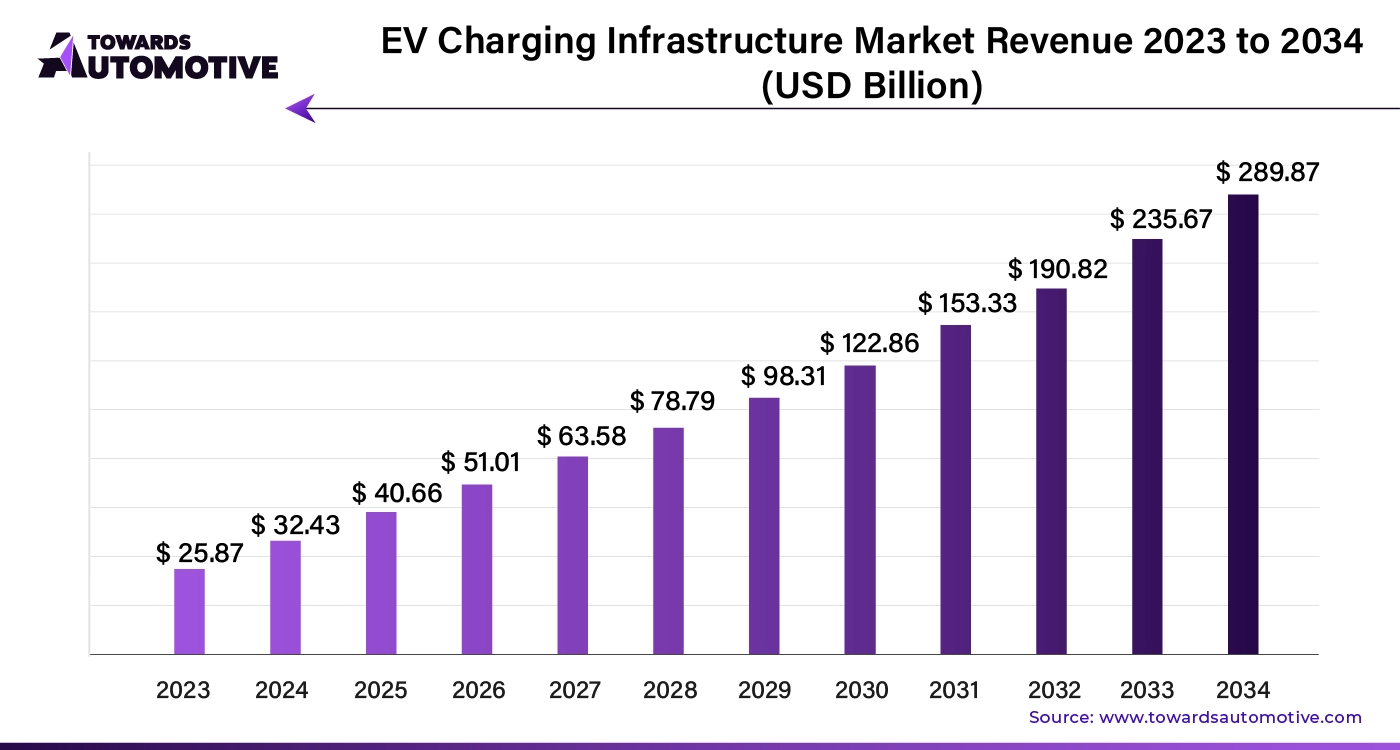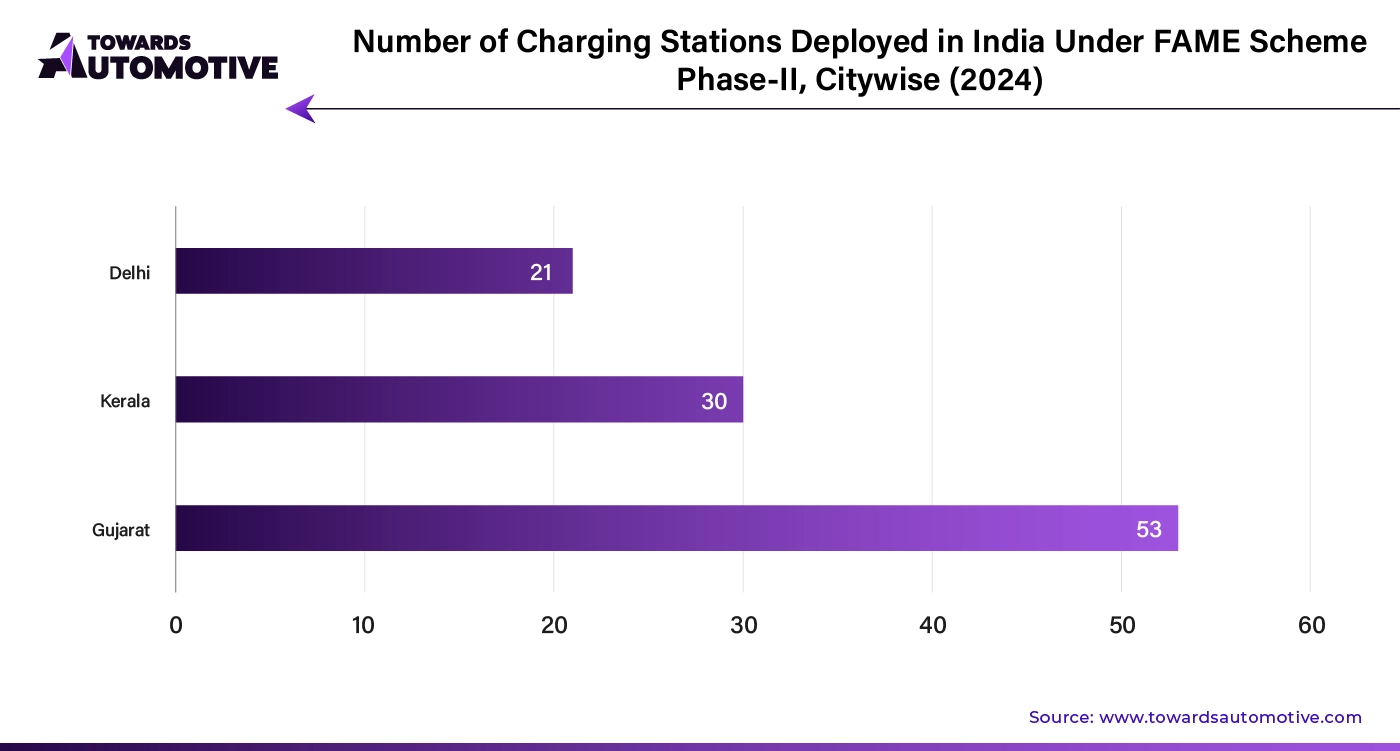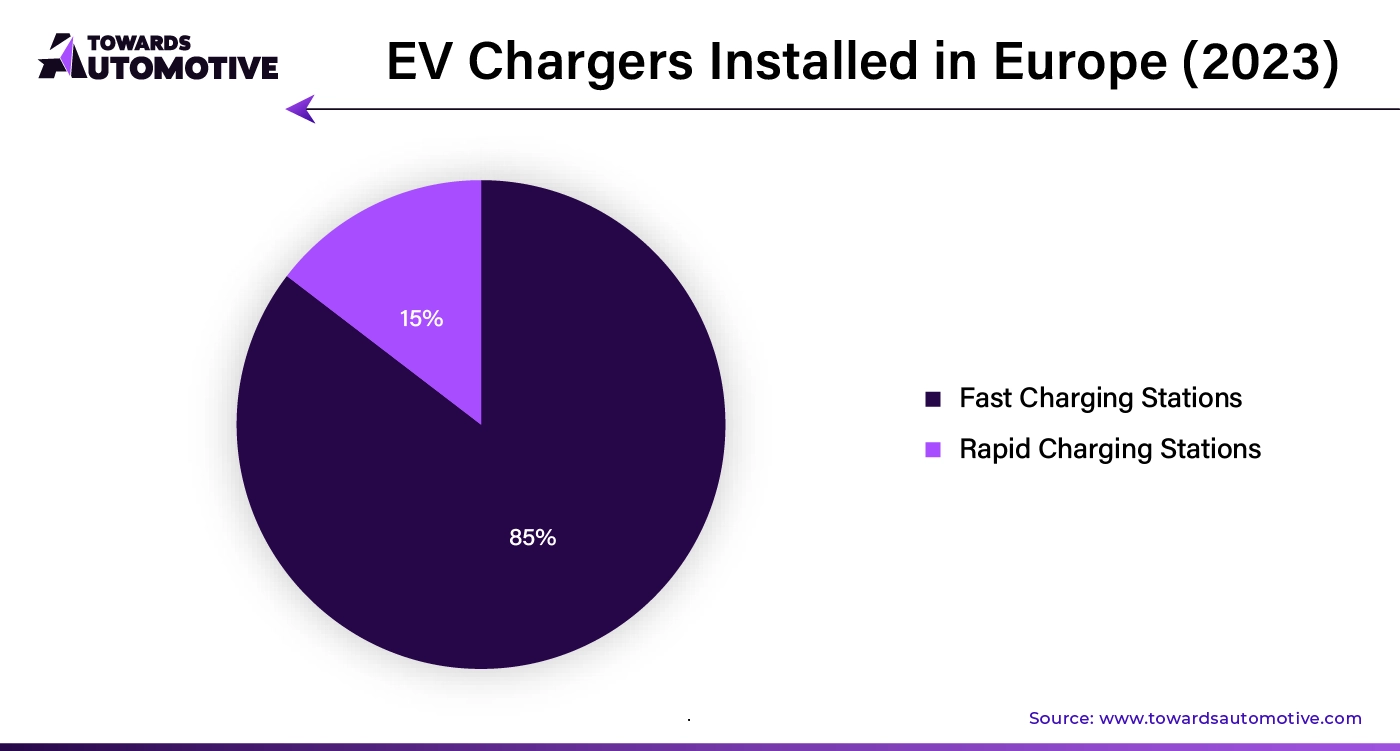March 2025

Senior Research Analyst

Reviewed By
The global ev charging infrastructure market size is calculated at USD 32.43 billion in 2024 and is expected to be worth USD 289.87 billion by 2034, expanding at a CAGR of 25.44% from 2024 to 2034.

The EV charging infrastructure market is experiencing rapid expansion as electric vehicles (EVs) gain traction and become an integral component of the global transition towards sustainable transportation. As the adoption of EVs accelerates, driven by increasing environmental awareness, government incentives, and advancements in battery technology, the demand for comprehensive and accessible charging solutions has surged. This market encompasses a wide range of components, including public and private charging stations, fast chargers, home charging systems, and the underlying network infrastructure that supports these installations.
Governments worldwide are implementing policies and regulations to promote the growth of EV charging infrastructure. Initiatives such as subsidies for charging station installations, stringent emissions targets, and investments in green transportation infrastructure are creating a favorable environment for market development. Additionally, advancements in technology are enhancing the efficiency and convenience of EV charging, with innovations like ultra-fast chargers and smart charging solutions that optimize energy usage and reduce charging times.
The market is also influenced by the increasing availability of EV models across various segments, including passenger vehicles, commercial fleets, and public transportation. As more consumers and businesses transition to electric mobility, the need for robust and widespread charging networks becomes increasingly critical. The integration of digital solutions, such as mobile apps for locating charging stations and managing charging sessions, further supports the growth of the market by enhancing user experience and accessibility.
Furthermore, collaborations between automotive manufacturers, technology providers, and energy companies are driving innovation and expanding the reach of charging infrastructure. As the EV charging infrastructure market evolves, it is poised to play a crucial role in supporting the broader adoption of electric vehicles, reducing carbon emissions, and advancing global sustainability goals.
Artificial Intelligence (AI) plays a pivotal role in the EV charging infrastructure market by enhancing efficiency, optimizing operations, and improving user experiences. AI algorithms are used to manage and optimize charging station networks, predicting peak usage times and dynamically adjusting charging rates to balance demand and prevent overloading. This helps in maximizing the utilization of available resources and reducing wait times for users.
AI also supports predictive maintenance by analyzing data from charging stations to anticipate potential equipment failures or malfunctions before they occur. This proactive approach ensures higher reliability and minimizes downtime, enhancing the overall efficiency of the charging network.
Furthermore, AI contributes to the integration of smart grid technologies, facilitating more effective energy management and integration with renewable energy sources. This helps in optimizing energy consumption and reducing operational costs, supporting the broader goals of sustainability and energy efficiency.
Overall, AI enhances the functionality, reliability, and user experience of EV charging infrastructure, playing a crucial role in advancing the adoption and efficiency of electric vehicles.
The growing adoption of electric vehicles (EVs) is a major driver of growth for the EV charging infrastructure market. As more consumers and businesses switch to electric mobility, the demand for accessible and reliable charging stations increases. This surge in EV adoption is largely fueled by environmental concerns, government incentives, and advancements in EV technology, such as improved battery ranges and lower overall costs. With EV sales growing globally, there is a pressing need for a robust network of charging stations to support the increasing number of vehicles on the road.
This rising demand prompts both public and private sector investments in charging infrastructure. Municipalities, retail centers, and commercial property owners are increasingly installing charging stations to accommodate EV users and attract eco-conscious customers. Additionally, the expansion of EV fleets in sectors like logistics, public transportation, and ridesharing further drives the need for high-capacity and strategically located charging points.
The EV charging infrastructure market faces several restraints, including high installation costs, particularly for fast chargers, and the need for significant grid upgrades to support widespread deployment. Additionally, the uneven distribution of charging stations across urban and rural areas creates accessibility challenges, slowing adoption in certain regions. Regulatory hurdles, varying standards across countries, and the slow pace of innovation in charging and battery technology also hinder market growth, limiting the expansion of a comprehensive and reliable charging network.
Smart chargers are creating significant opportunities in the EV charging infrastructure market by offering enhanced functionality, efficiency, and user experience. Unlike traditional chargers, smart chargers are equipped with advanced features such as real-time data monitoring, remote management, and adaptive charging capabilities. These features enable users to optimize charging schedules, manage energy consumption more effectively, and benefit from dynamic pricing based on grid demand or energy costs.
Smart chargers also integrate seamlessly with mobile apps and cloud-based platforms, allowing users to locate charging stations, monitor charging progress, and receive notifications. This connectivity improves the overall convenience and accessibility of EV charging, addressing key concerns such as range anxiety and charging availability. Furthermore, smart chargers support demand response programs by adjusting charging rates based on grid conditions, which helps balance energy loads and supports the integration of renewable energy sources.
For businesses and infrastructure providers, smart chargers present opportunities to enhance service offerings and generate additional revenue streams. They enable the implementation of subscription-based models, pay-per-use options, and value-added services such as advanced diagnostics and predictive maintenance. As the EV market expands and charging infrastructure becomes more sophisticated, smart chargers are poised to play a crucial role in driving growth, improving user experience, and supporting the transition to sustainable transportation.
The non-connected charging stations segment dominated the market. Non-connected charging stations are a significant driver of growth in the EV charging infrastructure market by providing a cost-effective and scalable solution for expanding charging networks. These standalone chargers operate independently of internet connections, making them easier to install and maintain, particularly in regions with limited connectivity or where a full network integration might not be necessary.
Additionally, non-connected stations play a crucial role in expanding access to charging in less densely populated areas, where demand may not be high enough to warrant the deployment of smart, connected charging infrastructure. By filling this gap, non-connected stations ensure that EV owners in more remote or underserved areas have access to essential charging facilities, reducing range anxiety and promoting EV adoption.
While the EV market continues to evolve with a focus on smart and networked infrastructure, non-connected charging stations remain a valuable component of the broader charging ecosystem. They provide a practical solution to meet growing demand, enabling a balanced, cost-effective expansion of charging networks and supporting the overall growth of the EV charging infrastructure market.
The commercial application segment held the largest share of the market. Commercial charging stations are a key factor driving the growth of the EV charging infrastructure market. With the rise in electric vehicle (EV) adoption, businesses across various industries are installing charging stations at commercial properties such as shopping centers, office buildings, hotels, and parking garages. These stations not only cater to the growing number of EV drivers but also enhance customer satisfaction and attract eco-conscious clientele, providing businesses with a competitive edge.
Furthermore, commercial charging stations enable businesses to generate additional revenue by offering paid charging services, turning parking lots into profit-generating assets. They also support corporate sustainability goals, as many companies transition their fleets to electric, requiring dedicated charging solutions for larger commercial vehicles.
The integration of advanced technologies, such as fast chargers and smart charging systems, allows commercial stations to meet the needs of high-traffic areas and optimize energy usage. This ensures a seamless charging experience for customers and employees while contributing to the overall expansion of the EV charging network.
As more businesses recognize the value of installing commercial charging stations, their widespread adoption is playing a crucial role in accelerating the growth of the EV charging infrastructure market, supporting the broader transition to electric mobility.
The level 2 charging segment held the dominant share of the market. Level 2 chargers are a significant driver of growth in the EV charging infrastructure market due to their balance of charging speed, cost-effectiveness, and convenience. Offering faster charging times compared to standard Level 1 chargers, Level 2 chargers can fully charge an electric vehicle in a few hours, making them ideal for both residential and commercial applications. This faster charging capability is essential for EV owners who need a reliable and quick way to recharge their vehicles at home, work, or public spaces like shopping centers or parking lots
Their affordability and ease of installation make Level 2 chargers a popular choice for businesses and municipalities looking to expand EV charging options. As electric vehicle adoption continues to rise, workplaces, apartment complexes, and public facilities are installing Level 2 chargers to accommodate growing demand. This increase in charging stations encourages more people to switch to EVs, as the availability of convenient charging options reduces range anxiety.
Furthermore, government incentives and subsidies for EV infrastructure often target Level 2 charger installations, boosting their deployment across urban and suburban areas. As a result, Level 2 chargers are playing a pivotal role in scaling the EV charging network, driving the overall growth of the EV charging infrastructure market.
The others segment dominated the market. This segment includes GB/T, Mennekes, and J1772 connectors. GB/T, Mennekes, and J1772 connectors play a vital role in driving the growth of the EV charging infrastructure market by providing standardized solutions that facilitate compatibility across different electric vehicles (EVs) and charging stations. These connectors ensure that EVs from various manufacturers can access charging infrastructure seamlessly, promoting widespread adoption and easing concerns about compatibility.
The J1772 connector, commonly used in North America, supports Level 1 and Level 2 charging, offering a widely accepted standard for both residential and public chargers. Similarly, Mennekes (Type 2) is the standard for most European countries, and its use in both slow and fast chargers makes it a versatile and reliable solution for EV owners. In China, the GB/T connector is the dominant standard, supporting the country's rapidly expanding EV market.
Standardization through these connectors simplifies the charging process, allowing infrastructure providers to design universal charging stations that can serve a wide range of vehicles. This encourages investment in charging networks, as infrastructure developers can cater to diverse consumer needs without complex system configurations.
The use of standardized connectors like GB/T, Mennekes, and J1772 drives the growth of the EV charging infrastructure market by creating a more interconnected and user-friendly charging ecosystem, supporting the global expansion of electric mobility.
The fast charger segment led the EV charging infrastructure market. Fast chargers are a key driver of growth in the EV charging infrastructure market due to their ability to significantly reduce charging times compared to Level 1 and Level 2 chargers. Fast chargers, also known as DC fast chargers, can replenish an electric vehicle's battery to 80% in as little as 20-30 minutes, making them an essential solution for long-distance travel, high-traffic areas, and commercial applications. This rapid charging capability addresses one of the primary concerns of EV owners—charging speed—enhancing convenience and reducing downtime.
The deployment of fast chargers is particularly crucial in public charging stations, highways, and urban centers, where EV drivers seek quick and efficient charging options. This availability encourages more people to adopt electric vehicles, knowing that long charging times will not hinder their mobility. Furthermore, the growing presence of fast chargers is vital for commercial fleets, ridesharing services, and logistics companies, enabling quick turnarounds for electric vans, buses, and delivery vehicles.
Government incentives and private investments are accelerating the installation of fast chargers, further boosting their role in expanding the EV charging network. As more businesses and municipalities integrate fast chargers into their infrastructure, they contribute to the overall growth and accessibility of the EV charging infrastructure market, facilitating the transition to electric mobility.
Asia Pacific dominated the EV charging infrastructure market share by 68% in 2023. The EV charging infrastructure market in Asia Pacific region is driven by a combination of regulatory support, technological advancements, and increasing consumer demand for electric vehicles (EVs). Government initiatives play a crucial role, with substantial investments and incentives aimed at expanding charging networks and supporting the transition to electric mobility. Policies such as tax credits for charging station installations, grants for infrastructure development, and stringent emissions regulations are creating a favorable environment for market growth.
Advances in charging technology, including fast chargers and ultra-fast charging stations, are improving the efficiency and convenience of EV charging. These innovations reduce charging times and increase the accessibility of charging points, addressing one of the primary concerns of EV owners and potential buyers.
The growing adoption of electric vehicles is also a major factor in China and Japan. As more consumers and businesses shift to EVs, the demand for a robust and widespread charging infrastructure increases. This trend is supported by the expanding availability of EV models across various segments, from passenger cars to commercial fleets, further driving the need for comprehensive charging solutions.
Additionally, collaborations between automotive manufacturers, technology providers, and energy companies are fostering the development of integrated and smart charging networks. These partnerships enhance the functionality and scalability of charging infrastructure, supporting the overall growth of the market.

Europe is expected to grow with a significant CAGR during the forecast period. The EV charging infrastructure market in Europe is driven by a confluence of supportive policies, technological advancements, and a strong commitment to environmental sustainability. European governments are at the forefront of promoting electric mobility, with ambitious targets for reducing carbon emissions and enhancing the adoption of electric vehicles (EVs). Initiatives such as the European Green Deal, which aims for carbon neutrality by 2050, and national strategies for expanding EV charging networks are creating a robust regulatory framework that fuels market growth. Substantial public and private investments are being directed towards building an extensive and accessible charging infrastructure across the continent.
Technological innovations are also a key driver, with advancements in charging technology improving both the speed and efficiency of EV charging. The development of ultra-fast chargers, wireless charging solutions, and smart charging networks is addressing the needs of a growing EV market and enhancing user convenience. These technologies are integral to overcoming range anxiety and making EVs a more attractive option for consumers.
Additionally, collaborative efforts between automotive manufacturers, technology providers, and energy companies are advancing the development of integrated and scalable charging solutions. These partnerships are fostering innovation and expanding the reach of charging infrastructure, contributing to the overall growth of the market.

By Charger Type
By Charging Type
By Installation Type
By Connector
By Level of Charging
By Connectivity
By Operation
By Deployment
By Application
By Region
March 2025
March 2025
March 2025
March 2025
Dr. Arjun Patel is a distinguished expert in the automotive industry, holding advanced degrees in Automotive Engineering and Mechanical Engineering. His expertise spans automotive market dynamics, technological advancements, and sustainable practices. Dr. Patel excels in conducting in depth research and analysis on market trends, consumer preferences, and the economic implications within the automotive sector. He is renowned for his insightful publications on topics such as electric vehicles, autonomous driving technologies, and the evolution of sustainable transportation solutions. Dr. Patels research contributions have significantly advanced understanding in the field, earning him recognition as a leading authority in automotive research and analysis.
We offer automotive expertise for market projections and customizable research, adaptable to diverse strategic approaches.
Contact Us